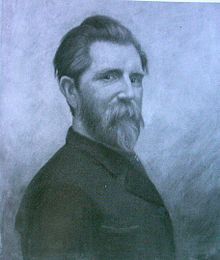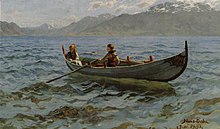Hans Dahl (painter)
Hans Dahl (born February 19, 1849 in Granvin , Hardangerfjord , † July 27, 1937 in Balestrand , Sognefjord ) was a Norwegian landscape and genre painter .
Life
Hans Dahl was a son of the infantry captain Hans Andreas Dahl (1818–1890) and his wife Eline Jacobine Wallendahl (* 1826). At the age of 16, Dahl presented good drawings of ethnological motifs. At first he was an officer in the Swedish army, but only got as far as second lieutenant. During his stay at the military academy, he began studying art with Johan Fredrik Eckersberg and Knud Bergslien and with Julius Middelthun at the Royal Norwegian School of Drawing in Christiania . In 1872 he took his leave and trained at the academy in Karlsruhe under Hans Fredrik Gude and Wilhelm Riefstahl . From 1873 to 1881 he went to the Düsseldorf Art Academy , where Eduard von Gebhardt and finally Wilhelm Sohn were his teachers in the master class . His younger brother, the landscape painter Hjalmar Alfred Dahl , also attended the Düsseldorf Academy in 1880/1881.
Dahl had a great ability to reproduce the light over the fjord , boats and water. He was unsurpassable, especially in depicting moving water. His few portraits are extremely forceful and devoid of conventions. He seldom painted pure landscapes. Most of his pictures are landscapes which, like Gude and Askevold, he animated in their early periods with relatively large genre scenes. With motifs such as the bridal voyage in the Sognefjord and the funeral voyage in the Sognefjord or Viking ships at full speed that are reminiscent of Gude, he continued Norwegian national romanticism.
Act
In the course of his life his range of topics narrowed increasingly. In later years Dahl mainly painted laughing peasant girls at the haymaking at the sunny fjord, which are reminiscent of the figure of Synnøve Solbakken by Bjørnstjerne Bjørnson and which German tourists liked to buy, but disavowed him as a serious artist.
Dahl did not go along with the change from romantic to modern around 1880. He was therefore sharply criticized, including by Christian Krohg , but shared this fate with other so-called Düsseldorfers, such as Anders Askevold and Morten Müller , who were highly valued in Norway . Dahl countered with self-published pamphlets. He laid down his artistic will in Norway's Art at Exhibitions (1901) and The Painters and the Audience (1929). Dahl sent numerous paintings to the National Gallery in Oslo for purchase, but their director Jens Thiis abruptly refused. Until 1998 the National Gallery in Oslo did not own a single painting by Dahl. The Städtische Galerie Dresden is the only German museum to have a picture by Dahl. In the art trade in both countries, however, his pictures fetch enormous prices.
In 1893 he had a dragon-style villa built on the banks of the Sognefjord in Balestrand, called Strandheim. He followed advice from Adelsteen Normann , who had settled there in 1890 to spend the summers here, but Dahl's villa was larger and more exuberant. Between 1888 and 1919 Dahl lived mostly in Berlin-Wilmersdorf and only spent the summers in Balestrand. Kaiser Wilhelm II , who went to Scandinavia every summer from 1889 to 1914, valued and visited him frequently. Apparently he valued his conservative approach to painting and his political stance. Dahl gave a ball in his garden every year, which the emperor also attended. In 1902 he was honored with the Norwegian Order of Saint Olav (knight 1st class). In 1910 Wilhelm II appointed him professor. Even Themistocles von Eckenbrecher visited Dahl in beach home and painted it in 1895 a door with still life.
Balestrand developed into the most visited tourist destination in Western Norway. When Wilhelm decided to erect a Frithjof and a Bele monument on the Sognefjord in 1910, he called on Dahl as a consultant. In 1913 the monuments were erected. In 1913, exercises by German warships took place in the fjords and were criticized by the Norwegian press. Hans Dahl tried to help the emperor. In 1913 he wrote in a Norwegian daily newspaper in his favor and stated that the German tourists "bring large sums into the country." Wilhelm took a painting by Dahl with him into exile in Doorn . After 1919 Dahl no longer traveled to Berlin, but stayed in Balestrand. Dahl was married to the German Helene Bewer, a daughter of the painter Clemens Bewer . His son was Hans Andreas Dahl . His grave is in the Tjugum churchyard.
Works and exhibitions (selection)
Museums: Oslo, National Gallery (6 drawings); Bergen, Historical Museum; Prague, National Gallery; Breslau, Museum ( walk to the last unction 1880); Vesterheim, Norwegian-American Museum, Decorah IA, USA ( girl with rake on flower-filled meadow by the sea )
Reproductions:
- A child of nature , a girl and a painter in a landscape; Wood engraving, in: Gazebo 1880
- On the ice rink (1881); Wood engraving, in: Deutsches Familienblatt (Schorer), 1881.2, p. 5
- Partridge Hunt (1883); Wood engraving in: Illustrirte Zeitung. No. 2.201, September 5, 1885
- On sunny waves , wood engraving, in: Deutscher Hausschatz 1902/03, p. 437
- Shipwreck , wood engraving, in: Aus Sturm und Noth, Schorer, Berlin undated
Solo exhibition:
- Oslo, Artes Galleri 1975
Exhibition participation:
- Philadelphia, 1876 World's Fair art exhibition
- Berlin, Great Art Exhibition 1877–1913 (1880: female attraction ; 1883: women's boarding school on the ice rink ); 1890 ( On lonely ways , A modern Paris (norwegian fjord) , In the moonlight (norwegian fjord) ); 1891 ( Summer day in Norway , In a strong wind. Western Norway ); 1893 ( A question , Ripe grass (area near mountains) , In high waves ); International art exhibition 1896 ( Ingeborg am Meer , Um die Welle ); 1897 ( longing; norwegian high mountains ); 1899 ( Trau, look, whom , approaching storm ); 1901 ( On the Sunny Fjord; West Coast of Norway , Against Wind and Waves; West Norway , On a quiet board , Sharp through the waves ); 1902 ( Mischievous Girls; Western Norway , Evening by the Sea (Ingeborg) , Auf high Welle ); 1904 ( On the right track , Norwegian Mountain Lake ); 1904 ( When in doubt; scene from the west coast of Norway , Die Jeaersüchtige (Norwegian Mountains) ); 1905 ( Sunday morning in Norway ); 1906 ( At sea when the sun is setting , mountain flowers ); 1907 ( Am stillen See ); 1909 ( over sunny waves )
- Paris, art exhibition at the 1878 World's Fair
- Munich, International Art Exhibition in the Glaspalast, Munich 1879 ( A game of waves ); 1883 ( The Rest ); 1888 ( fresh breeze , arrival at the church near Ullenswang, Hardanger ); 1899 ( Norwegian Summer Night; Sogne Fjord ); 1907 ( over surging waves )
- Gothenburg, Nordic Art Exhibition 1881
- Vienna, International Art Exhibition in the Künstlerhaus 1882 ( female attraction ); Jubilee art exhibition 1888 ( On the Norwegian west coast : In the Norwegian high mountains )
- Bremen, exhibition of the North German Association in 1882 ( motif from Norway and homecoming )
- Copenhagen, Charlottenburg 1883
- Paris, Paris Salon 1884, 1896, 1897, 1899
- Düsseldorf, Kunstverein 1885 ( motif from the Norwegian coast ); 1886 ( Norwegian fishing boat ); 1888 ( far from the world )
- Kristiania, annual exhibition 1886
- Paris, art exhibition at the 1889 World's Fair
- Berlin, art exhibition of the Association of Berlin Artists 1890 ( drive to the baptism )
- Chicago, Art Exhibition at the Columbian World's Fair 1893
- Düsseldorf, German National Art Exhibition 1907 ( Against the Wind )
- Düsseldorf, Art Museum: Nordic painters of the Düsseldorf School 1963
Fonts
- Hans Dahl: Wake up! You peoples of the north. Leipzig 1915.
- Hans Dahl: Norges art paa udstillingerne. Kristiania 1901.
- Hans Dahl: painting and audience. Balestrand 1929.
literature
- Dahl, Hans. In: Friedrich von Boetticher: painter works of the 19th century. Contribution to art history. Volume 1/1, sheets 1–30: Aagaard – Heideck. Ms. v. Boetticher's Verlag, Dresden 1891, pp. 197-198 ( archive.org ).
- Friedrich Jansa (Hrsg.): German visual artists in words and pictures. Leipzig 1912.
- Carl Wille Schnitler : Dahl, Hans . In: Ulrich Thieme (Hrsg.): General Lexicon of Fine Artists from Antiquity to the Present . Founded by Ulrich Thieme and Felix Becker . tape 8 : Coutan-Delattre . EA Seemann, Leipzig 1912, p. 270 ( Textarchiv - Internet Archive ).
- Dahl, Hans . In: Hans Vollmer (Hrsg.): General Lexicon of Fine Artists of the XX. Century. tape 5 : V-Z. Supplements: A-G . EA Seemann, Leipzig 1961, p. 409 .
- Emanuel Bénézit (ed.): Dictionnaire Critique et Documentaire des Peintres, Sculpteurs, Dessinateurs et Graveurs de tous les temps et de tous les pays , vol. III, 1976.
- Dahl, Hans. In: Norsk kunstnerleksikon . (Norwegian).
- Max Bewer: Hans Dahl. In: The Art of Our Time - A Chronicle of Modern Art Life. 10th year (1899). Hanfstaengl, Munich 1899, pp. 57-72 ( Textarchiv - Internet Archive ).
- Hans Paffrath (Ed.): Lexicon of the Düsseldorf School of Painting 1819–1918. Volume 1: Abbema – Gurlitt. Published by the Kunstmuseum Düsseldorf in the Ehrenhof and by the Paffrath Gallery. Bruckmann, Munich 1997, ISBN 3-7654-3009-9 , pp. 258-259 (fig.).
- Dahl, Hans . In: General Artist Lexicon . The visual artists of all times and peoples (AKL). Volume 23, Saur, Munich a. a. 1999, ISBN 3-598-22763-9 , p. 408.
- Arne Melkild: Art Narliv. Leikanger 1993, pp. 70-76.
Web links
- "Tysk keisar i norsk fjord" . Der Kaiser am Sognefjord and especially Hans Dahl, documentary 1985
- renegadetribune.com: The Norwegian Paintings of Hans Dahl
Individual evidence
- ↑ finding aid 212.01.04 student lists the Dusseldorf Art Academy (download in XLS format, 6.5 MB)
| personal data | |
|---|---|
| SURNAME | Dahl, Hans |
| BRIEF DESCRIPTION | Norwegian landscape and genre painter |
| DATE OF BIRTH | February 19, 1849 |
| PLACE OF BIRTH | Granvin , Hardangerfjord |
| DATE OF DEATH | July 27, 1937 |
| Place of death | Balestrand , Sognefjord |



